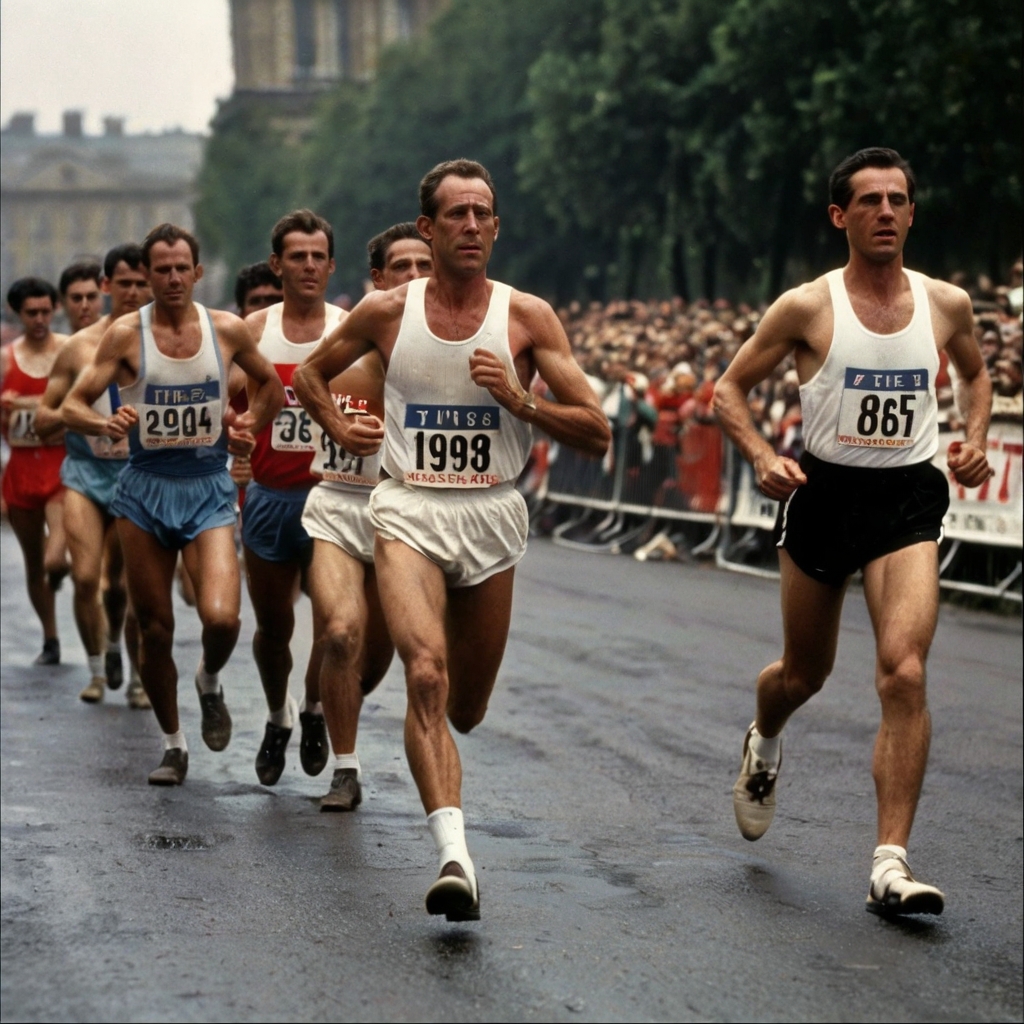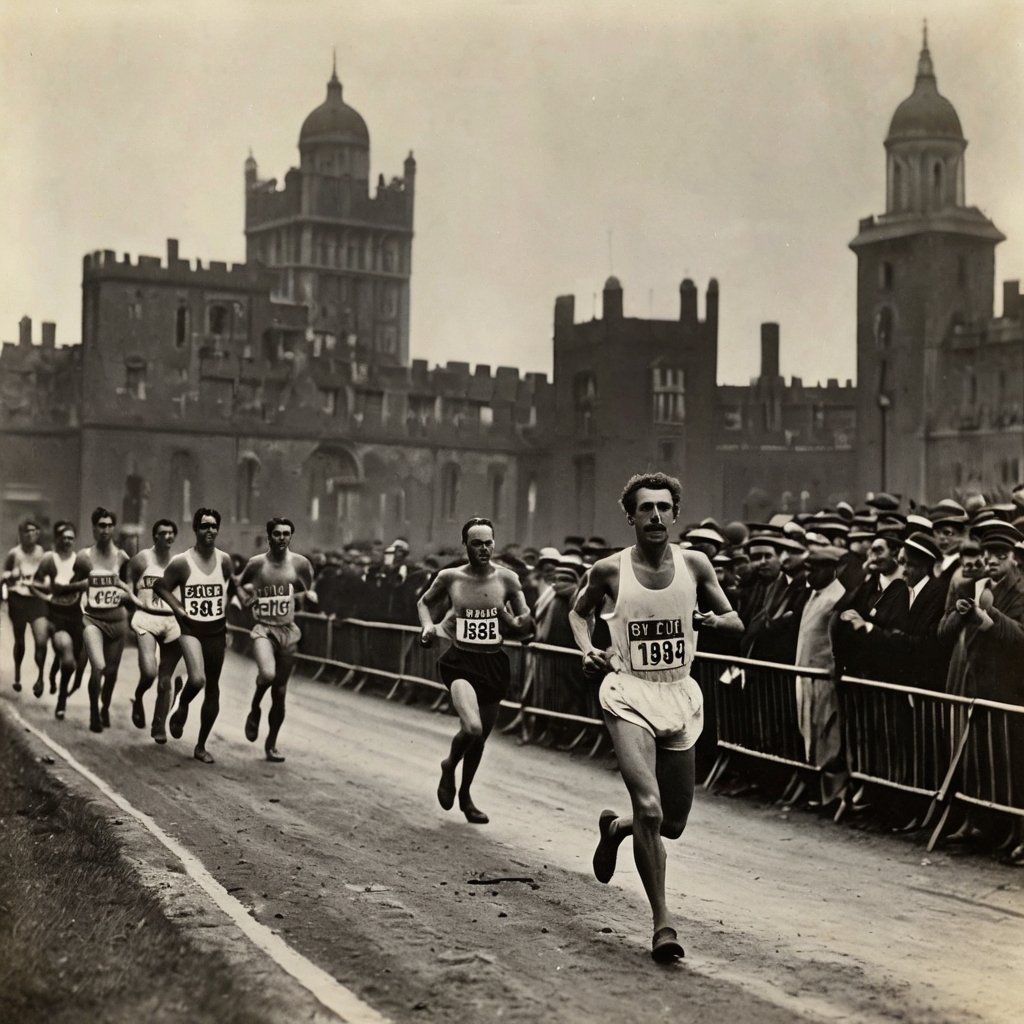The marathon’s 26.2-mile distance has a fascinating royal connection that changed running history. Marathon races ranged between 25 and 26.5 miles at first, drawing inspiration from the legendary Greek messenger Pheidippides’s 25-mile run from Marathon to Athens in 490 B.C.
Queen Alexandra’s specific request at the time of 1908 London Olympics transformed everything. She wanted the race to begin at Windsor Castle and end right in front of the royal box. The royal family’s preference added exactly 385 yards to the 26-mile course. This created today’s standard marathon distance of 26.2 miles (42.195 kilometers) that became official in 1921.
The sort of thing I love about this piece is the complete story behind the marathon’s distance. It traces the journey from ancient Greek origins to modern standardization and shows why precise measurements matter in these challenging courses today.
Table of Contents
- 1
- 2 The Ancient Origins of Marathon Running
- 3 Early Marathon Races and Varying Distances
- 4 The 1908 London Olympics Change Everything
- 5 How 26.2 Miles Became Official
- 6 Converting Marathon Distance
- 7 Here are some FAQs about why is a marathon 26.2 miles:
- 7.1 How did they come up with 26.2 miles for a marathon?
- 7.2 Why is a marathon such a random distance?
- 7.3 What is the myth of the marathon?
- 7.4 Why not run 26 miles before marathon?
- 7.5 Why is the number 26.2 significant to a marathon runner?
- 7.6 What is the legend behind the marathon?
- 7.7 What is a ghost marathon?
- 7.8 Who was the first person to run a marathon under 2 hours?
- 7.9 Why is a marathon 26.2 miles ancient Greece?
The Ancient Origins of Marathon Running
Marathon running’s roots go back to a defining moment in ancient Greek history – the Battle of Marathon in 490 BCE. The Athenians and a small force from Plataea stood against a massive Persian invasion force. Greek warriors crushed the larger Persian army in what became a historic victory.
The Battle of Marathon story
The battle’s numbers tell an amazing story:
- Greek casualties: 192 soldiers
- Persian losses: 6,400 warriors
- Greek force: 10,000 citizen-soldiers
- Persian army: Estimated 18,000-25,000 soldiers
The Greeks secured victory around noon. Nine of the ten Athenian clans then rushed back to Athens. These brave warriors covered 25 miles while carrying their full armor and weapons. They needed to protect their city from possible Persian naval attacks.
First recorded long-distance messengers
Pheidippides, a professional courier known as a “hemerodrome” or day-runner, performed the most incredible running feat of this battle. His most important achievement wasn’t the well-known Marathon-to-Athens run. He accomplished something even more extraordinary before the battle began.
Herodotus, the first historian to document these events, tells us Pheidippides ran from Athens to Sparta to ask for military support. He covered 150 miles in just two days – an amazing feat. After delivering his message, he learned Spartan forces couldn’t help immediately due to religious observances. He then made the return journey to Athens.
Pheidippides reportedly met the god Pan on Mount Parthenion during this grueling run. This supernatural encounter became part of the historical record, though some scholars think it was an exhaustion-induced hallucination.
The popular story of Pheidippides running from Marathon to Athens to announce victory and dying from exhaustion first appeared in Plutarch’s works 600 years after the events. Modern scholars think this version might be a “romantic invention.” Lucian remains the only classical source that contains all elements of this famous story.
Early Marathon Races and Varying Distances
Marathon races went through substantial changes before reaching today’s standard distance. The first modern Olympic Games in 1896 became a turning point in marathon history.
First Olympic marathon in 1896
Athens hosted the first Olympic marathon with a distance of 40 kilometers (24.85 miles). A Greek water-carrier named Spyridon Louis won the race with an impressive time of 2 hours, 58 minutes, and 50 seconds. A Greek Championship event happened earlier to qualify runners, where 11 competitors ran from Marathon to Athens. This became the first marathon race ever hosted.
Eighteen men stood at the starting line on April 10, 1896. The race had only four foreign runners, and Hungarian Gyula Kellner was the only one who had completed a marathon distance in a time trial. The foreign middle-distance runners showed surprising endurance. They managed to keep running until they had to stop at 23km, 32km, and 37km.

Different lengths across competitions
Marathon distances varied substantially after the Athens Olympics. The distances evolved this way:
- 1896 Olympics: 40 kilometers (24.85 miles)
- 1912 Olympics: 40.2 kilometers (24.98 miles)
- 1920 Olympics: 42.75 kilometers (26.56 miles)
The first seven Olympic Games used six different marathon distances between 40 and 42.75 kilometers. Most non-Olympic marathons stuck to either 40 kilometers or 25 miles, including the Paris and St. Louis Olympic races. The 1920 Antwerp Olympics had the longest recorded distance at 42,750 meters.
These varying distances created problems for record-keeping. Officials couldn’t formally recognize records because marathon distances weren’t standardized. This issue sparked discussions about setting a fixed distance for future races.
The sport grew more popular despite these variations. Paris hosted another marathon event just two months after the first Olympic marathon. Runners raced from the city center to the town of Conflans. These early races became the foundations of what would later become one of athletics’ most prestigious events.
The 1908 London Olympics Change Everything
The 1908 London Olympics marked a defining moment in marathon history when a royal request forever shaped the race’s distance. The original plan called for a 25-mile course from Windsor to the White City Stadium. A series of changes reshaped this distance into what we know today as the standard 26.2 miles.
Windsor Castle starting point
Royal priorities led to a new starting location. The Princess of Wales brought her children from Frogmore to watch this historic event. King Edward VII granted permission to start the race on the East Lawn near Windsor Castle’s private East Terrace. This ensured the public would stay away from the proceedings.
The course measurement went through careful planning:
- Original distance: approximately 25 miles
- Added distance at Windsor: 700 yards inside castle grounds
- Final adjustment: Additional yards to finish in front of royal box
- Total distance: 26 miles and 385 yards
The royal family’s special request
Queen Alexandra’s specific request reshaped marathon history forever. She wanted the race to begin on Windsor Castle’s lawn so young royals could watch from their nursery window. The finish line needed to be right in front of the royal box at the Olympic stadium. These arrangements created the exact distance of 26 miles and 385 yards.
Recent research has verified this historic measurement’s accuracy. King Charles allowed researchers to access Windsor Castle’s private grounds. Their precise measurements confirmed the original 1908 course length. This definitively established the 42.195-meter distance that remains standard today.
The race kicked off at 11:30 AM, perfectly timed with Windsor Castle’s changing of the guard. Royal protocol shaped the marathon’s organization into a truly regal event. The route weaved through London’s outer suburbs, creating a path that would become legendary in running history.
How 26.2 Miles Became Official
The International Amateur Athletic Federation (IAAF) made a landmark decision in May 1921, after 16 years of different marathon distances. They set the official marathon distance at 26 miles and 385 yards (42.195 kilometers), which matched the exact length from the 1908 London Olympics.
The 1921 standardization
Marathon distances used to range between 24 and 26.2 miles before this standardization. The 1924 Paris Olympics became the first major event to use this new standard distance. This change brought much-needed consistency to marathon racing and made accurate record-keeping possible for all international events.
Modern measurement methods
Today’s marathon measurement uses advanced techniques to certify precise distances. The International Association of Athletics Federations (IAAF) has clear rules:
- Courses must be measured with an uncertainty not exceeding 0.1% of the total distance
- A mandatory “short course prevention factor” adds one meter per kilometer
- Marathon courses need an extra 42 meters beyond the standard distance
The fine-tuned bicycle method remains the main measurement technique that IAAF/AIMS recognizes. This technique works by calculating the distance one bicycle wheel covers in a complete turn, then counts the total turns needed for the full course. World record attempts need two measurements before the race, and officials must measure again after the race if someone sets a world record.
Course measurement focuses on the “shortest possible route” (SPR) that runners might take. Digital photogrammetry and aerial photography have improved this process by creating precise base maps. These advanced methods make sure runners complete the full marathon distance, whatever path they choose through the course.
Precise measurements matter most in elite competitions. A marathon course must measure exactly 42.195 kilometers plus the safety factor to qualify for international competition. This precision will give similar distance conditions for every world record attempt and keeps the sport fair and honest.
Converting Marathon Distance
Marathon runners need to know their way around both imperial and metric measurements. The official marathon distance is exactly 42.195 kilometers or 26 miles and 385 yards.
Miles to kilometers conversion
Runners should know the exact conversion formula to track their distance. One mile equals 1.609344 kilometers. A marathon’s exact measurement comes to 26.2187574564543 miles.
This conversion table helps runners track their progress at common marathon checkpoints:
| Miles | Kilometers |
|---|---|
| 5 | 8.05 |
| 10 | 16.09 |
| 13.1 | 21.1 |
| 20 | 32.19 |
| 26.2 | 42.195 |
Why precision matters in races
Competitive integrity depends on precise marathon measurements. Race organizers add one meter per kilometer as a “short course prevention factor” to the total distance. A certified marathon course measures between 42,195 and 42,279 meters.
Course certification demands multiple precision layers:
- Official courses need an uncertainty below 0.1% of total distance
- Certified measurers use calibrated bicycles with Jones Counters
- Temperature changes affect measurement tools that need fine-tuning
Today’s race certification standards make sure courses aren’t too short. Races measure slightly long on purpose, with marathons including an extra 42 meters beyond the standard distance. Runners will complete at least the full marathon distance, whatever path they take through the course.
Elite competitions and record attempts need this measurement precision. World records need exact distance certification. Course officials carefully measure the shortest possible route, known as the “racing line”. There’s another reason runners often cover extra distance during races – crowds and course conditions stop them from following the exact measured path.
GPS devices are popular with runners but don’t work for official course measurement. These devices show different distances because:
- GPS accuracy varies by 0.1% over marathon distances
- Runners rarely stick to the exact measured course line
- Environmental factors affect GPS signals
Race organizers need certification from governing bodies like USATF or AIMS to host official events. The certification process makes sure every marathon, from local races to Olympic events, meets the same distance standards. This keeps the sport’s competitive integrity intact in races of all sizes.
The marathon distance has come a long way from an ancient Greek messenger’s legendary run to become one of the world’s most precisely measured athletic events. Queen Alexandra’s royal request at the 1908 London Olympics made the now-standard 26.2-mile distance official, though Pheidippides’ original experience covered roughly 25 miles. Those extra 385 yards reshaped the scene of marathon running forever.
Today’s marathons show evidence of both historical tradition and scientific precision. Race organizers use advanced measurement techniques to ensure every certified course matches the exact 42.195-kilometer standard. GPS devices might show different distances, but official certification processes guarantee that runners cover the full marathon distance, whatever path they choose through the course.
Marathon distance standardization has enabled accurate record-keeping and fair competition in international events since 1921. These 26.2 miles mean more than just a physical challenge – they connect us to ancient Greek heritage and British royal history. Modern marathons continue this legacy while upholding the highest athletic competition standards.
Here are some FAQs about why is a marathon 26.2 miles:
How did they come up with 26.2 miles for a marathon?
The marathon was originally about 25 miles, based on the legend of Pheidippides running from Marathon to Athens in ancient Greece. The distance changed to 26.2 miles in the 1908 London Olympics to accommodate the British royal family’s viewing area. This final measurement became the standard, which is why a marathon is 26.2 miles.
Why is a marathon such a random distance?
The marathon distance of 26.2 miles seems random, but it was standardized after the 1908 London Olympics. Organizers extended the course so the race could start at Windsor Castle and finish in front of the royal box. This change was later made official, which is why a marathon is 26.2 miles long.
What is the myth of the marathon?
The myth behind the marathon is based on the story of Pheidippides, an ancient Greek soldier who ran from the battlefield of Marathon to Athens to deliver news of victory. According to legend, he ran the entire way without stopping, then collapsed and died after delivering his message. This tale inspired the modern marathon, which is why 26.2 miles is called a marathon.
Why not run 26 miles before marathon?
Most training plans suggest stopping short of the full 26.2 miles before race day to avoid injury and fatigue. Running the entire distance in training can lead to overuse injuries and exhaustion, reducing performance on race day. Proper marathon training gradually builds endurance, ensuring runners can complete 26.2 miles when it matters most.
Why is the number 26.2 significant to a marathon runner?
For marathon runners, 26.2 miles represents the ultimate test of endurance, discipline, and mental strength. It is the official race distance, adopted from the 1908 London Olympics. Many runners proudly display “26.2” as a symbol of their accomplishment, which is why a marathon is 26.2 miles long.
What is the legend behind the marathon?
The legend of the marathon comes from the story of Pheidippides, a Greek messenger who ran from the city of Marathon to Athens to announce a military victory. After delivering the message, he collapsed and died. This story inspired the modern marathon distance, which is why a marathon is 26.2 miles.
What is a ghost marathon?
A ghost marathon refers to a virtual or unofficial race where runners complete the distance on their own, rather than in an organized event. These races allow runners to participate remotely, often tracking their progress via apps. Some also use the term for long, solitary runs meant to replicate the challenge of an official marathon.
Who was the first person to run a marathon under 2 hours?
Eliud Kipchoge became the first person to run a marathon under 2 hours on October 12, 2019, during the INEOS 1:59 Challenge. He finished in 1 hour, 59 minutes, and 40 seconds, though the race was not an official marathon due to pacers and controlled conditions. His achievement redefined human endurance in the sport.
Why is a marathon 26.2 miles ancient Greece?
The marathon distance is linked to ancient Greece because it is inspired by the legend of Pheidippides. He reportedly ran from Marathon to Athens to deliver a victory message after the Battle of Marathon. Although his actual route was shorter, the modern race evolved to 26.2 miles, which is why a marathon is 26.2 miles.



